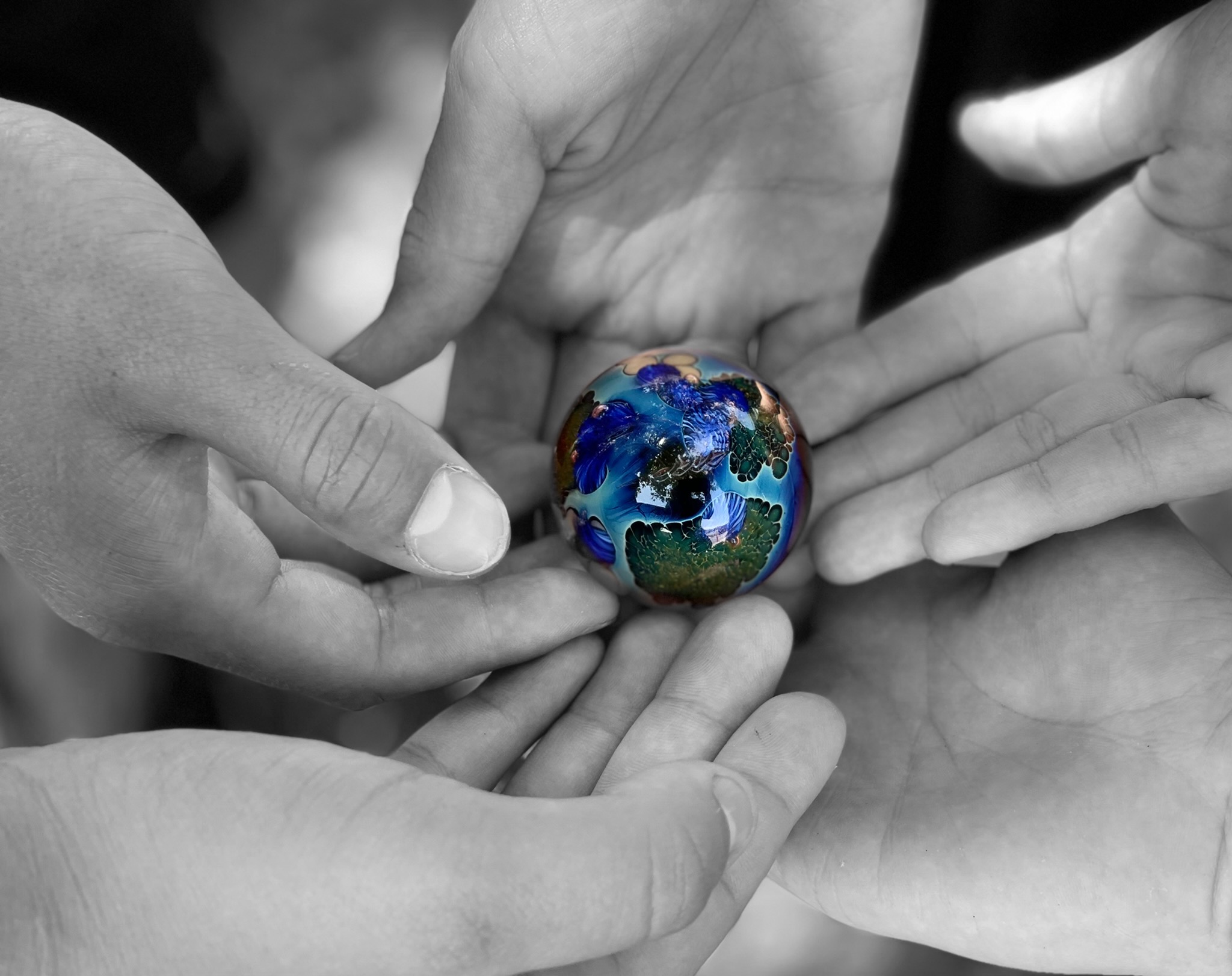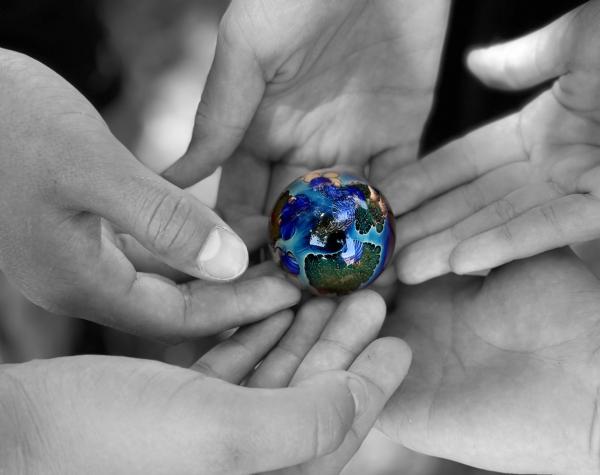KID REPORTERS’ NOTEBOOK
Seeing the World Through an Artist’s Eyes


Quade and his friends hold an Infinity Planet created by master glassblower Josh Simpson.
Artist Josh Simpson creates tiny glass planets that are meant to delight his audience. Decades ago, he gave glassblowing demonstrations to local students in his Springfield, Massachusetts, studio. Simpson started by showing the middle-schoolers how to make marbles. After seeing a breathtaking image from NASA (the National Aeronautics and Space Administration), he got the idea to encase miniature planets in glass.
A master glass blower, Simpson has been shaping and molding glass into art for more than 50 years. His creations, which have been showcased around the world, range from the small planetary orbs to the world’s largest paperweight. The 100-pound Megaplanet was commissioned by the Corning Museum of Glass (CMOG) in New York State.
“Simpson is a wonderful artist and teacher who connects the natural world to glass in a way that creates joy,” said Amy Schwartz, director of The Studio, Corning’s glassmaking school.
“THE INFINITY PROJECT”
More than 3,000 of Simpson’s palm-sized planets are hidden around the world. He got the idea to hide his tiny glass creations in 1976, after finding children’s marbles from long ago in his garden. In 2000, he invited others to help him hide the planets. He calls the archeological adventure “The Infinity Project.”
“The Infinity Project connects people to glass because we’re endlessly fascinated by those tiny little worlds and how they’re created,” Schwartz said. “Every time I see someone pick up one of his planets, they always are incredibly intrigued.”
Last May, I sent a proposal to Simpson’s studio and was selected to hide an Infinity Planet. After hiding the planet on the Pacific Crest Trail in Southern California in June, I interviewed Simpson via Zoom. Here are highlights from our conversation, which has been edited for length and clarity.
What is it like to work with hot glass?
Molten glass is one of the most challenging materials for an artist to work with. The hot liquid just wants to drip on the floor. It will burn you if you touch it. Working with a material like that is amazing and challenging, but it’s also really fun.
What is the role of science in glassmaking?
The chemistry, math, and technology involved in melting glass are incredibly important. Glass is made of minerals that are mined from the Earth, including sand, lime, and soda ash [a sodium salt of carbonic acid used to make soap powders, glass, and other products]. Colors in glass are created by adding metallic oxides. For example, cobalt and silver make blue, and gold makes a red, magenta color. I love inventing formulas and new colors of glass that have never been seen before.
“The hidden planets will be a mystery and a surprise for somebody in the future,” Simpson says.
When did you make your first planet?
I started making planets for kids. The first week that my Massachusetts studio was opened in 1976, a schoolteacher asked if students could visit. Every Wednesday, they would come to the studio, and I would make them marbles. One night, I thought of the Earthrise photo [a photo of Earth and part of the Moon’s surface] taken by an Apollo astronaut in 1968. It looked like a blue marble floating in the black void of space. The next day, instead of making marbles, I made little planets to entertain the kids and show them how glass is made.
How has your wife, retired NASA astronaut Cady Coleman, influenced your art?
My childhood heroes were NASA astronauts, so being married to one is really fun. I have visited incredible places like the Lyndon B. Johnson Space Center [in Houston, Texas], and enjoy seeing films of Earth viewed from outer space.
Can you tell our readers about the Infinity Project?
It is this crazy idea to hide my unsigned, tiny glass planets all over the world for archeologists and people to find. Glass is made of natural elements but can last thousands of years. The hidden planets will be a mystery and a surprise for somebody in the future.
Students meet with Simpson and his wife, retired NASA astronaut Cady Coleman, in Simpson’s art studio in Springfield, Massachusetts.
Where are the planets hidden?
There are so many of them. There is a planet at the North Pole and one at the South Pole, one on Mount Everest and one on K2 in Asia. The planets are also underwater—in oceans, the Mediterranean Sea, and the Azores [an archipelago composed of nine volcanic islands in the North Atlantic Ocean]. Planets have even gone up into space with different astronauts.
Where would you like to hide planets in the future?
I’d like to hide more planets in museums. I currently have hidden planets in the archives of some famous museums. Now, anyone can propose a place they would like to hide an Infinity Planet. I like the idea that it’s a gift. It’s an amazing feeling to know that these planets will surprise someone in the future.
